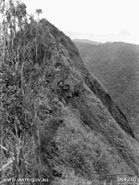| Finisterre Range campaign | |||||||
|---|---|---|---|---|---|---|---|
| Part of World War II, Pacific War | |||||||
 Members of "C" Company, Australian 2/9th Battalion, digging in at a newly-occupied part of Shaggy Ridge on 23 January 1944 | |||||||
| |||||||
| Belligerents | |||||||
|
|
| ||||||
| Commanders and leaders | |||||||
| Alan Vasey | Masutaro Nakai | ||||||
| Strength | |||||||
| 1 division | 1 brigade | ||||||
| Casualties and losses | |||||||
| ? | ? | ||||||
| |||||
The Finisterre Range campaign, also known as the Ramu Valley–Finisterre Range campaign, was a series of actions in the New Guinea campaign of World War II. Several actions in the campaign are sometimes known collectively as the Battle of Shaggy Ridge. The campaign began with an Allied offensive in the Ramu Valley, from 19 September 1943, and concluded when Allied troops entered Madang on 24 April 1944. During the campaign, Australian and U.S. forces assaulted Japanese positions in the Finisterre Range of New Guinea.The central geographical and strategic feature of the campaign was the imposing Shaggy Ridge, running north-south in the Finisterres.
Forces[]
The Japanese formation in the campaign was the Nakai Detachment, a brigade-sized formation detached from the Japanese 20th Division under Major General Masutaro Nakai.[1] It faced the Australian 7th Division, consisting of approximately 17,000 men[2] under Major General George Vasey, and made up of the 18th, 21st and 25th Brigades, along with the 2/6th Commando Squadron.[3]
Outline of the campaign[]
The campaign began in September 1943 following the 7th Division's drive on Lae,[4] as part of the wider New Guinea campaign, which saw the 9th Division carrying out operations along the Huon Peninsula on the coast to the east, while the 7th moved towards the west.[5] Carrying out a number of smaller-scale operations, the units of the 21st and 25th Brigades advanced up the Markham and Ramu Valleys. Apart from a significant engagement around Kaiapit, where the 2/6th Commando Squadron captured the village and killed over 200 Japanese, the Australians were barely resisted as they advanced and they arrived in Dumpu in early October.[3][6]
Following this, the 7th Division provided security for a number of airfields that were constructed in the territory they had captured in the valleys,[7] however, the Japanese remained in strong possession of the Finisterre Range, and their positions at Kankiryo Saddle north of the Ramu river and the 1,500 m (4,900 ft) high razorback ridge named Shaggy Ridge, continued to threaten the airfields.[6] This threat manifested itself in the road that the Japanese were attempting to build from Madang on the coast inland to Nadzab, via Bogadjim along which they were hoping to advance through to Dumpu.[3][6]
Thus, the Kankiryo Saddle and Shaggy Ridge were of vital strategic importance for both the Japanese and the Australians. For the Japanese, it provided a strong obstacle to the Australian advance north towards the coast, while also offering them the ground along which they could launch their own offensive in order to recapture the territory they had lost earlier in the campaign.[6] For the Australians, the Japanese positions on the high ground signalled threat and their commander, Vasey, came to the decision that he would have to launch an offensive in order to capture this ground.[6]
This led to a number of battles in the steep mountains of the Finnisterres. In October, battles took place at Palliser's Hill[8] and then later at Johns' Knoll where the Australians first managed to capture the knoll and then held it against a determined Japanese counterattack.[3] In November, the 25th Brigade relieved the 21st as the offensive was maintained,[6] and later in December and into January heavy fighting took place around Shaggy Ridge and the Kankiryo Saddle.[3] Shortly after Shaggy Ridge was captured, the 18th Brigade was replaced by the 15th Brigade, a Militia formation,[9] and the 7th Division advanced towards Bogadjim, linking up with the American forces there on the coast, before finally securing the Huon Peninsula on 24 April 1944 when they took Madang.[3]
Operation Cutthroat[]
The major Australian offensives on Shaggy Ridge—codenamed Operation Cutthroat—were launched by the 18th Brigade on 19 January. The plan called for the brigade's three battalions to converge on Kankiryo Saddle from three different directions:
- the 2/12th Battalion was to advance from Canning's Saddle, east of Shaggy Ridge, and attack two well-defended knolls on the northern end of Shaggy Ridge, known as Prothero I and II
- the 2/9th Battalion would attack northwards along Shaggy Ridge itself, to take McCaughey's Knoll (by way of Green Sniper's Pimple)
- the 2/10th Battalion would advance along Faria Ridge, which lay to the east of Shaggy Ridge and joined it at Kankiryo Saddle.
In Popular Culture[]
Fighting during the campaign was featured in the Australian documentary Jungle Patrol (1944).
Notes[]
References[]
- Bradley, Phillip (2004). On Shaggy Ridge—The Australian Seventh Division in the Ramu Valley: From Kaiapit to the Finisterres. South Melbourne: Oxford University Press. ISBN 0-19-555100-1.
- Dexter, David (1961). Volume VI – The New Guinea Offensives. Australia in the War of 1939–1945. Canberra: Australian War Memorial. http://www.awm.gov.au/histories/chapter.asp?volume=22. Retrieved 2006-12-16.
- Dickens, Gordon (2005). Never Late: The 2/9th Australian Infantry Battalion 1939–1945. Loftus, NSW: Australian Military History Publications. ISBN 1-876439-47-5.
- Johnston, Mark (2007). The Australian Army in World War II. Botley, Oxford: Osprey Publishing. ISBN 978-1-84603-123-6.
Image gallery[]
The original article can be found at Finisterre Range campaign and the edit history here.


